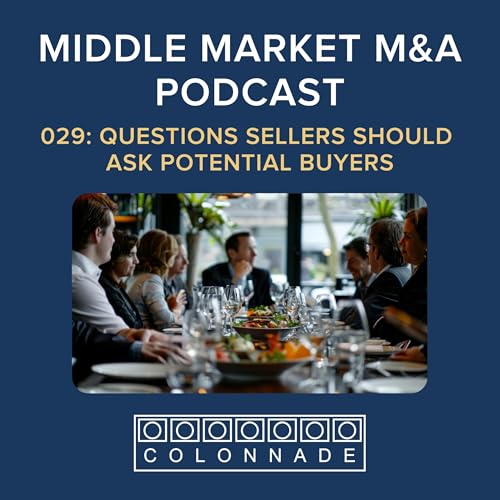In this episode, Gina Cocking and Jeff Guylay pick up their discussion around the due diligence process related to the sale of a company. This episode is a great add-on to the previously released four-episode series exploring the due diligence process: EP003: Business aspects of due diligence EP004: Legal aspects of due diligence EP005: Accounting aspects of due diligence EP006: Technology aspects of due diligence As we explore the organizational aspects of a due diligence data room, you'll hear the reminiscing of both Gina and Jeff as they remember their days on Wall Street physically managing the data rooms of decades past when there were literally rooms full of documents that buyers would make appointments to review while the analysts on the deal watched. You'll hear how much data rooms have transformed in recent years with the birth of the electronic data room. Get ready for a call-to-action, which Gina describes as a "resolution" that you can make any time, to get your company's documents located, organized, and filed in a neat system to be ready for a transaction. Thus our title for the episode: Get your Ducks in a Row. We answer the following questions in this podcast episode: What are data rooms, and why are they so important in the due diligence process? (2:00) What were data rooms like in decades past? (2:30) What are data rooms like today? (4:30) What is contained in an electronic data room? (6:20) Are data rooms static or do they change over time? (10:00) How is confidentiality protected in a data room? (16:00) What can a company do to prepare for a transaction? (20:00) What do you suggest companies do immediately after listening to this episode in regards to data rooms? (27:00) What are data rooms, and why are they so important in the due diligence process? (2:00) Jeff: Big picture, data rooms are the electronic location of all the materials that we help our clients collect and collate during our process of selling the company. They contain all the information that buyers and investors will need to complete a transaction. So it's everything from articles of incorporations, to financial models, to contracts, etc. Gina: The data room is critical in any buyside or sellside process. The data room is where all the documents are kept that the buyers have access to when reviewing the business. We also give access to the buyers' accountants, attorneys, HR consultants, marketing consultants, etc. Datarooms are all electronic (online) nowadays, but it has not always been that way. What were data rooms like in decades past? (2:30) Jeff: As an analyst in investment banking in the '90s, I would sit in a physical data room on Wall Street. We would have buyers come through, and they would have to sign into the data room and show ID. It was a room full of documents where buyers could spend several days going through documents. They were not able to take any documents out of the data room. They could ask to selectively photocopy certain documents, and we analysts would photocopy them. The business folks, the attorneys, the accountants would come in in-person and spend days digging through the documents. Gina: I remember being stuck in Bethlehem, Pennsylvania in a basement of a chemicals manufacturing facility for about two weeks. One of the challenges in a physical data room is you couldn't have multiple buyers come in at the same time. You also had to double-check all the files when everyone left to make sure nobody took a document. What are data rooms like today? (4:30) Jeff: The efficiency with electronic data rooms has been a game-changer. You can have 30 professionals across various functions looking at documents at the same time and really increase the cycle time of the transaction. Everybody has a unique password, they sign in (online). We can see what documents they've downloaded, which ones they've reviewed, and which ones they haven't looked at. You can see who is really being active. It's a great tool for us as advisors to see who is most interested in a transaction. What is contained in an electronic data room? (6:20) Gina: In the data room, you will have various workstreams based on who will be asking for documents. You'll have workstreams for business, accounting, tax, legal, technology consultants, marketing, HR, and insurance professionals. From a business perspective, it will include all monthly reporting packages, KPIs (Key Performance Indicators), MD&As (Management Discussion and Analysis of the financial results); whatever a business is using to manage the business on a day-to-day basis. Business information will also include company presentations made to outside shareholders and banks, internal presentations, presentations made to clients, information on past employees, current employees, payroll data, insurance information, claims history, insurance applications. Jeff: The data room acts as a central repository of all the information that describes the ...
続きを読む
一部表示
 2025/04/1526 分
2025/04/1526 分 29 分
29 分 30 分
30 分 41 分
41 分 35 分
35 分 30 分
30 分 32 分
32 分 39 分
39 分
